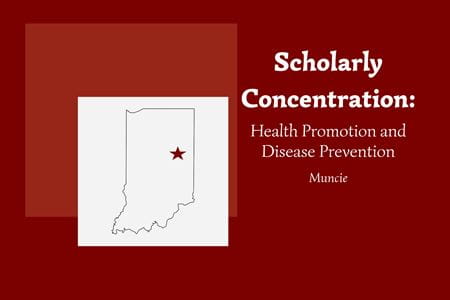At Indiana University School of Medicine, the Health Promotion and Disease Prevention scholarly concentration empowers medical students to explore how lifestyle, community engagement and evidence-based interventions can improve health outcomes. This concentration emphasizes hands-on outreach, research and collaboration with local organizations to address disparities and promote wellness across diverse populations, reducing healthcare costs and strengthening community health.
Fast facts about the concentration
- Location: Muncie campus
- Co-directors: Larry Fromm, PhD; Michael Litt, PhD; and Lynn Witty, MD.
Meet the co-directors
The Health Promotion and Disease Prevention scholarly concentration is co-directed by Larry Fromm, PhD, an adjunct professor of biochemistry and molecular biology; Michael Litt, PhD, an adjunct associate professor of medical and molecular genetics; and Lynn Witty, MD, an adjunct clinical assistant professor of medicine.
Witty brings a unique perspective to the program, shaped by her own experience as a patient. After an illness left her homebound for 10 years, she developed a renewed appreciation for the patient experience. Witty has a long history of research and outreach, including founding programs at the Ball State Healthy Lifestyle Center.
“I enjoy helping students find an interest and narrow it to a question they want to answer, then work with them to learn how to set up an efficient, accurate and doable investigation,” Witty said.
What students can expect
The Health Promotion and Disease Prevention scholarly concentration can be easily tailored, allowing students to pursue research topics that align with their interests and engage directly with community members through outreach. The program emphasizes learning how to assess health needs, communicate effectively and implement evidence-based lifestyle interventions.
Projects emerge from outreach events, screenings and educational initiatives, which are frequently done in collaboration with Ball State University pre-med students. As IU medical students gain proficiency, they expand into other areas of interest, often tied to their scholarly projects.
Recent initiatives include a partnership with Ball State’s athletic department, where medical students — several of whom are former athletes — are developing a lecture series on topics such as injury recovery, mental health and substance use. These sessions will include a research component aimed at improving both performance and life skills for student athletes.
The Muncie campus offers a unique blend of academic rigor and community connection. Located near Ball State and IU Health Ball Memorial Hospital, students benefit from close proximity to clinical sites, outreach partners and a supportive learning environment.
Socially, the campus fosters a collegial atmosphere. Students often live nearby in the Campus Village apartments or in the mansion where students stay when rotating to Muncie, which also hosts frequent gatherings. Whether you're outgoing or more reserved, you'll find a welcoming environment.
Is this the right fit?
Fromm and Witty said the Health Promotion and Disease Prevention concentration is ideal for students who are passionate about making a difference in their communities and enjoy working directly with people. Whether you're interested in family medicine, internal medicine, public health or another specialty, the skills gained through this concentration — communication, assessment and collaboration — are universally valuable.
“If you are in medicine to make a difference and enjoy interacting with and learning about the people in your community, this is a great scholarly concentration and place to enjoy your years of medical school,” Fromm said. “We welcome curious, empathetic and innovative students who want to make a difference just by doing something you want to do anyway.”
Students are encouraged to speak directly with the concentration’s co-directors, campus leadership or current participants to learn more. The co-directors agreed that the Muncie community is highly receptive to student-led initiatives, and the program has a strong history of follow-through, transparency and mutual respect.
“We receive significant positive responses, including volunteers who show up, when we indicate our program and goals,” Witty said. “This stems from our history of giving back to the community, recognizing our responsibility for honesty, following through with our commitments and our consistent desire to do best by the people who participate in our studies.”
One of the most important things medical students can learn, Witty added, is how to communicate well with patients or research participants, both to obtain accurate and reproducible information and to address a possible solution.
“Through lots of interactions and conversations, you can help build understanding and trust, opening the door to helping someone improve their health — assets that will benefit you personally and professionally,” she said.
Examples of student research
Students in this concentration have completed a wide range of impactful projects, many of which have been published or implemented in the community. Examples include:
- Maternal and Infant Health: OB Navigation Outcomes
- Barriers to Home Gardening: A Limitation for Improved Nutrition and Taste
- Food Prep Videos: Meal Prep for Your Food Pantry Finds
- Naloxone and EMS Calls for Overdose: Does Distance from the Box Make a Difference in the Number of Calls?
- Mindfulness Instruction and Intervention for Women in Addiction
- Mental health services referrals
- Vaping Education in Youth-Prevention: The TOXIC Program
- Vaping Education in College Students: Assessment of Why, When they Make the Worst Decision of their Lives
